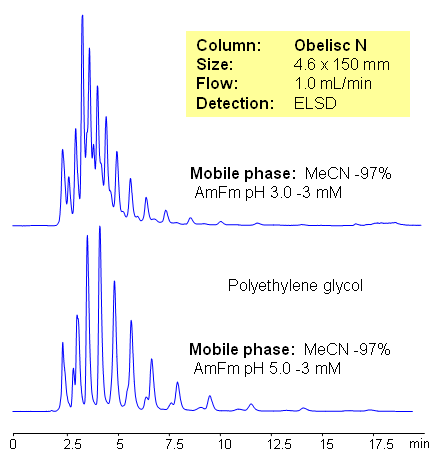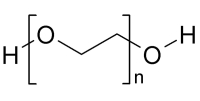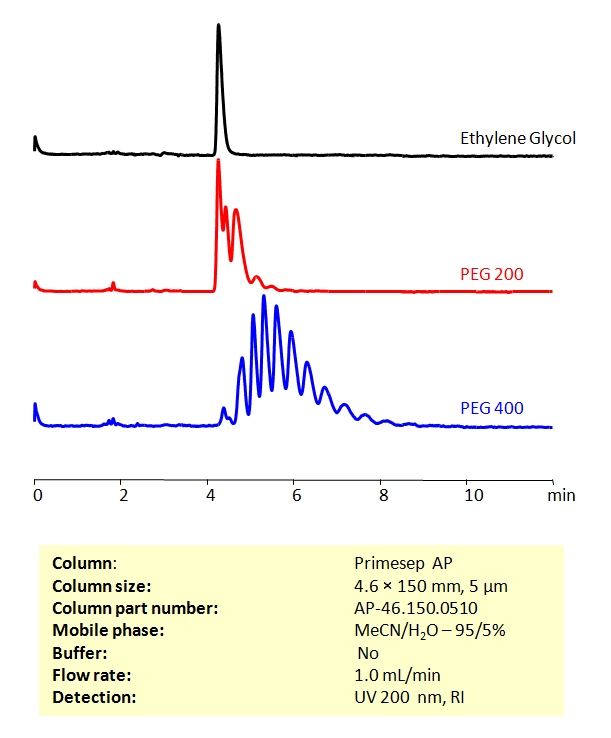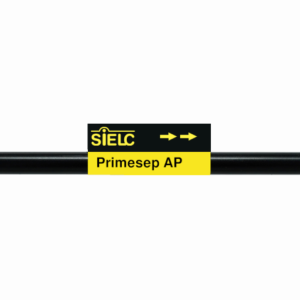Applications:
HPLC Method For Analysis of Ethylene Glycol and Polyethylene Glycol (PEG) on Primesep AP Column
September 14, 2021
HPLC Method for Ethylene Glycol, Polyethylene Glycol on Primesep AP by SIELC Technologies
High Performance Liquid Chromatography (HPLC) Method for Analysis of Ethylene glycol, PEG 200, PEG 400.
Polyethylene glycol (PEG) has a low toxicity and is used in a variety of products (creams, laxatives, lubricants). When attached to various protein medications, polyethylene glycol allows a slowed clearance of the carried protein from the blood. This makes for a longer acting medicinal effect, reduces toxicity, and allows longer dosing intervals.
HILIC separation can be used to determine polyethylene glycol content in various formulations using ELSD, RI detection, or LC/MS detection. HPLC separation of oligomers can be achieved by changing the amount of acetonitrile.
| Column | Primesep AP, 4.6 x 150 mm, 5 µm, 100 A, dual ended |
| Mobile Phase | MeCN/H2O – 95/5% |
| Buffer | No |
| Flow Rate | 1.0 ml/min |
| Detection | UV, 200 nm, RI |
| LOD* | Ethylene glycol 6 ppm (UV) |
| Class of Compounds | Diol |
| Analyzing Compounds | Ethylene Glycol, Polyethylene Glycol |
Application Column
Primesep AP
Column Diameter: 4.6 mm
Column Length: 150 mm
Particle Size: 5 µm
Pore Size: 100 A
Column options: dual ended
Polyethylene Glycol

HILIC HPLC Separation of Polyethylene Glycol (PEG)
August 22, 2008

Polyethylene glycol (PEG) has low toxicity and is used in a variety of products (creams, laxatives, lubricants). When attached to various protein medications, polyethylene glycol allows a slowed clearance of the carried protein from the blood. This makes for a longer acting medicinal effect, reduces toxicity, and allows longer dosing intervals. HILIC separation of polyethylene glycol can be used to determine polyethylene glycol content in various formulations using ELSD, RI detection, or LC/MS detection. HPLC separation of oligomers can be achieved by changing amount of acetonitrile or buffer pH.
Application Column
Obelisc N
SIELC has developed the Obelisc™ columns, which are mixed-mode and utilize Liquid Separation Cell technology (LiSC™). These cost-effective columns are the first of their kind to be commercially available and can replace multiple HPLC columns, including reversed-phase (RP), AQ-type reversed-phase, polar-embedded group RP columns, normal-phase, cation-exchange, anion-exchange, ion-exclusion, and HILIC (Hydrophilic Interaction Liquid Chromatography) columns. By controlling just three orthogonal method parameters - buffer concentration, buffer pH, and organic modifier concentration - users can adjust the column properties with pinpoint precision to separate complex mixtures.
Select options




